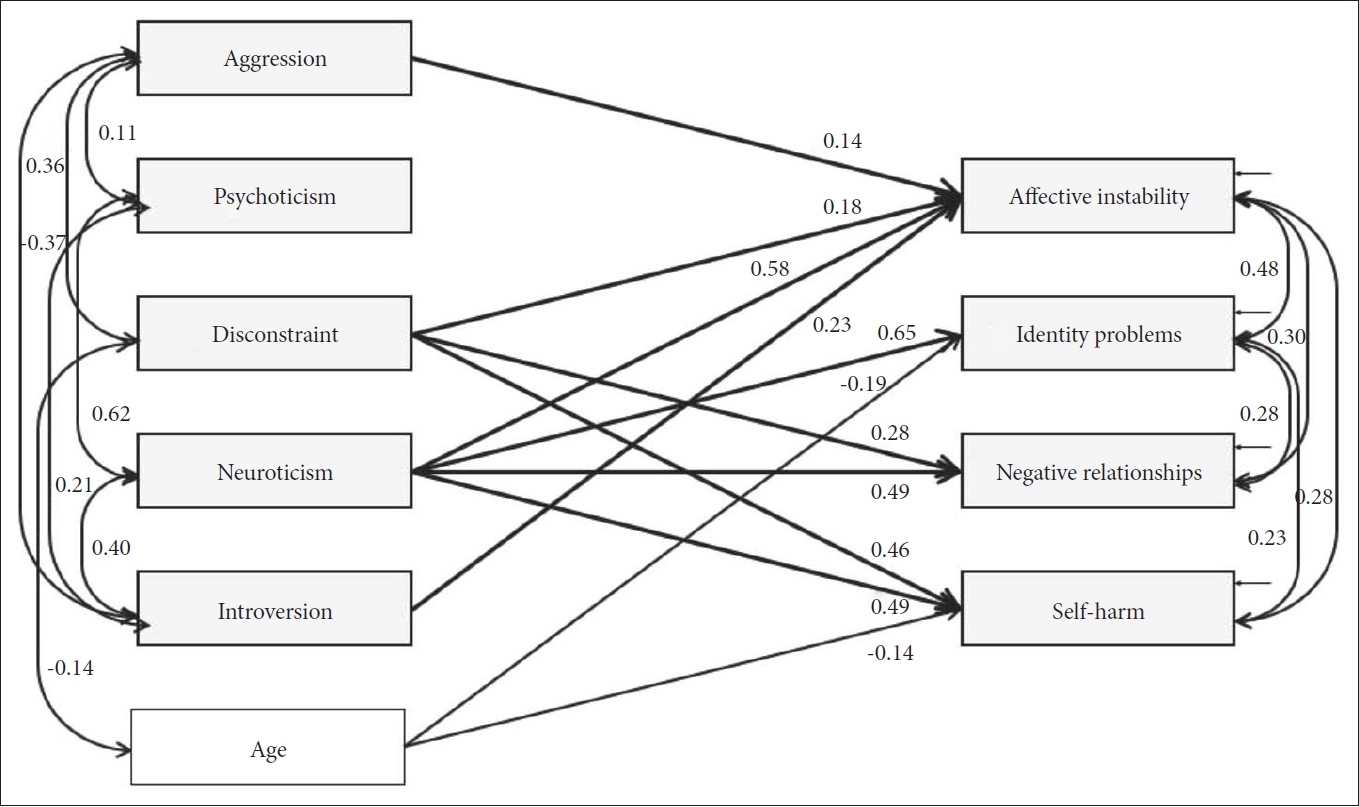 |
 |
- Search
| Psychiatry Investig > Volume 18(12); 2021 > Article |
|
Abstract
Objective
Methods
Results
Notes
Availability of Data and Material
Data sharing not applicable to this article as no datasets were generated or analyzed during the study.
Conflicts of Interest
The authors have no potential conflicts of interest to disclose.
Author Contributions
Conceptualization: Kyu-Sic Hwang. Data curation: Min Jin Jin. Formal analysis: Min Jin Jin. Investigation: Min Jin Jin. Methodology: Min Jin Jin. Project administration: Chan-Mo Yang, Seung-Ho Jang, Sang-Yeol Lee. Resources: Kyu-Sic Hwang, Chan-Mo Yang, Seung-Ho Jang, Sang-Yeol Lee. Software: Min Jin Jin. Supervision: Sang-Yeol Lee. Validation: Kyu-Sic Hwang. Visualization: Min Jin Jin. Writing—original draft: Min Jin Jin. Writing—review & editing: Min Jin Jin, Hye-Jin Lee, Kyu-Sic Hwang, Jae-Hee Lee.
Funding Statement
None
Table 1.
Table 2.
| AGGR | PSYC | DISC | NEGE | INTR | BOR-A | BOR-I | BOR-N | BOR-S | BOR total | |
|---|---|---|---|---|---|---|---|---|---|---|
| AGGR | - | |||||||||
| PSYC | 0.24** | - | ||||||||
| DISC | 0.42*** | 0.17* | - | |||||||
| NEGE | 0.15 | 0.63*** | 0.09 | - | ||||||
| INTR | -0.38*** | 0.18* | -0.16 | 0.35*** | - | |||||
| BOR-A | 0.23** | 0.45*** | 0.23** | 0.68*** | 0.39*** | - | ||||
| BOR-I | 0.12 | 0.46*** | 0.07 | 0.66*** | 0.32** | 0.72*** | - | |||
| BOR-N | 0.26** | 0.39*** | 0.28*** | 0.52*** | 0.20* | 0.59*** | 0.53*** | - | ||
| BOR-S | 0.27** | 0.40*** | 0.48*** | 0.53*** | 0.14 | 0.59*** | 0.50*** | 0.45*** | - | |
| BOR total | 0.27** | 0.52*** | 0.32*** | 0.73*** | 0.32*** | 0.90*** | 0.84*** | 0.76*** | 0.78*** | - |
| M (SD) | 46.22 (10.79) | 56.74 (15.01) | 47.01 (11.63) | 60.41 (15.00) | 62.49 (17.46) | 58.20 (14.12) | 59.82 (14.19) | 59.24 (14.51) | 55.98 (15.37) | 60.62 (15.36) |
MMPI-2-PSY-5, Minnesota Multiphasic Personality Inventory-2 personality psychopathology five; PAI-BOR, Personality Assessment Inventory-Borderline Feature; AGGR, aggressiveness; PSYC, psychoticism; DISC, disconstraint; NEGE, negative emotionality/neuroticism; INTR, introversion/low positive emotionality; BOR-A, borderline features-affective instability; BOR-I, borderline features-identity diffusion; BOR-N, borderline features-negative relationships; BOR-S, borderline features-self harm; BOR, borderline features; M, mean; SD, standard deviation
Table 3.
| Step | B | SE | β | t | F | R2 | ∆R2 | |
|---|---|---|---|---|---|---|---|---|
| 1 | 8.09*** | 0.10 | 0.10 | |||||
| Age | -0.26 | 0.08 | -0.27 | -3.36** | ||||
| Gender | -3.06 | 2.57 | -0.10 | -1.19 | ||||
| 2 | 67.24*** | 0.67 | 0.57 | |||||
| Age | -0.15 | 0.05 | -0.16 | -3.14** | ||||
| Gender | -0.70 | 1.69 | -0.02 | -0.42 | ||||
| AGGR | 0.19 | 0.09 | 0.13 | 2.21* | ||||
| PSYC | 0.04 | 0.06 | 0.04 | 0.63 | ||||
| DISC | 0.31 | 0.07 | 0.24 | 4.25*** | ||||
| NEGE | 0.58 | 0.07 | 0.57 | 8.71*** | ||||
| INTR | 0.17 | 0.05 | 0.19 | 3.27** | ||||
MMPI-2-PSY-5, Minnesota Multiphasic Personality Inventory-2 personality psychopathology five; PAI-BOR, Personality Assessment Inventory-Borderline Feature; AGGR, aggressiveness; PSYC, psychoticism; DISC, disconstraint; NEGE, negative emotionality/neuroticism; INTR, introversion/low positive emotionality
Table 4.
REFERENCES









